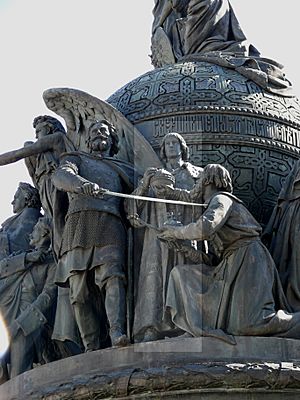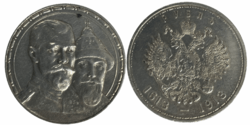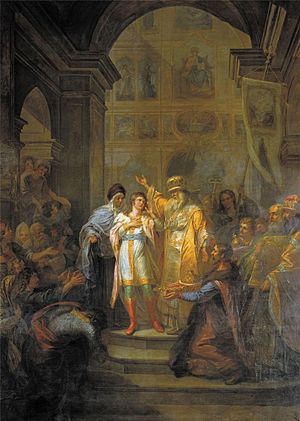Michael of Russia facts for kids
Quick facts for kids Michael I |
|||||
|---|---|---|---|---|---|

J. H. Wedekind's copy of a portrait
|
|||||
| Tsar of Russia | |||||
| Reign | 21 February 1613 – 12 July 1645 | ||||
| Coronation | 22 July 1613 | ||||
| Predecessor | Dmitry Troubetskoy (as the head of the Zemsky government) | ||||
| Successor | Alexis | ||||
| Born | 22 July 1596 Moscow, Russia |
||||
| Died | 23 July 1645 (aged 49) Moscow, Russia |
||||
| Burial | Archangel Cathedral | ||||
| Consort |
Maria Vladimirovna Dolgorukova
(m. 1624; died 1625)Eudoxia Lukyanovna Streshneva
(m. 1626) |
||||
| Issue among others... |
|
||||
|
|||||
| House | Romanov | ||||
| Father | Feodor Nikitich Romanov | ||||
| Mother | Kseniya Shestova | ||||
| Religion | Eastern Orthodoxy | ||||
| Signature |  |
||||
Michael I (Russian: Михаи́л Фёдорович Рома́нов, Mikhail Fyodorovich Romanov) (22 July [O.S. 12 July] 1596 – 23 July [O.S. 13 July] 1645) became the first Russian Tsar of the House of Romanov after the zemskiy sobor of 1613 elected him to rule the Tsardom of Russia.
He was the son of Feodor Nikitich Romanov (later known as Patriarch Filaret) and of Xenia (later known as "the great nun" Martha). He was also a first cousin once removed of the last Rurikid Tsar Feodor I through his great-aunt Anastasia Romanovna, who was the mother of Feodor I, and through marriage, a great-nephew in-law with Tsar Ivan IV of Russia. His accession marked the end of the Time of Troubles. During his reign, Russia conquered most of Siberia, largely with the help of the Cossacks and the Stroganov family. Russia had extended to the Pacific Ocean by the end of Michael's reign.
Life and reign
Michael's grandfather, Nikita, was brother to the first Russian Tsaritsa Anastasia and a central advisor to Ivan the Terrible. As a young boy, Michael and his mother had been exiled to Beloozero in 1600. This was a result of the recently elected Tsar Boris Godunov, in 1598, falsely accusing his father, Feodor, of treason. This may have been partly because Feodor had married Ksenia Shestova against Boris' wishes. Michael was unanimously elected Tsar of Russia by a national assembly on 21 February 1613, but the delegates of the council did not discover the young Tsar and his mother at the Ipatiev Monastery near Kostroma until 24 March. He had been chosen after several other options had been removed, including royalty of Poland and Sweden. Initially, Martha protested, believing and stating that her son was too young and tender for so difficult an office, and in such a troublesome time.
Michael's election and accession to the throne form the basis of the Ivan Susanin legend, which Russian composer Mikhail Glinka dramatized in his opera A Life for the Tsar.
In so dilapidated a condition was the capital at this time that Michael had to wait for several weeks at the Troitsa monastery, 75 miles (121 km) off, before decent accommodation could be provided for him at Moscow. He was crowned on 22 July 1613, on his seventeenth birthday. The first task of the new tsar was to clear the land of the countries occupying it. Sweden and Poland were then dealt with respectively by the peace of Stolbovo (17 February 1617) and the Truce of Deulino (1 December 1618). The most important result of the Truce of Deulino was the return from exile of the tsar's father, who henceforth took over the government till his death in October 1633, Michael occupying quite a subordinate position.
Michael's reign saw the greatest territorial expansion in Russian history. During his reign, the conquest of Siberia continued, largely accomplished by the Cossacks and financed by the Stroganov merchant family.
Tsar Michael suffered from a progressive leg injury (a consequence of a horse accident early in his life), which resulted in his not being able to walk towards the end of his life. He was a gentle and pious prince who gave little trouble to anyone and effaced himself behind his counsellors. Sometimes they were relatively honest and capable men like his father; sometimes they were corrupted and bigoted, like the Saltykov relatives of his mother. He was married twice. He was married off to Princess Maria Vladimirovna Dolgorukova in 1624, but she became ill, and died in early 1625, only four months after the marriage. In 1626, he married Eudoxia Streshneva (1608–1645), who bore him 10 children, of whom four reached adulthood: the future Tsar Alexis and the Tsarevnas Irina, Anna, and Tatyana. Michael's failure to wed his eldest daughter, Irina, with Count Valdemar Christian of Schleswig-Holstein, a morganatic son of King Christian IV of Denmark, in consequence of the refusal of the latter to accept Orthodoxy, so deeply afflicted him as to contribute to bringing about his death. Tsar Michael fell ill in April 1645, with scurvy, dropsy, and probably depression. His doctors prescribed purgatives which did not improve his condition; and after fainting in church on 12 July, he died on 23 July 1645.
Michael's governments


The two government offices (prikazes) that were most important politically were Posolsky Prikaz ("Foreign Office") and Razryadny Prikaz (a Duma chancellery and a personnel department for both central and provincial administration including military command). Those offices could be pivotal in struggles between Boyar factions, so they were traditionally headed not by Boyars but by dyak (professional clerks).
The first head of the Posolsky Prikaz under Michael was Pyotr Tretyakov until his death in 1618; he conducted policy of allying with Sweden against Poland. The next one, Ivan Gramotin had a reputation of a Poloniphile; this appointment was necessary to bring forth Filaret's release from captivity. In the mid-1620s Filaret began preparations for war with Poland; Gramotin fell in his disfavour and was fired and exiled in 1626. The same fate was shared by Efim Telepnev in 1630 and Fedor Likhachov in 1631 – they too tried to soothe Filaret's belligerent approach. Ivan Gryazev, appointed in 1632, was promoted from second ranks of bureaucracy to fulfill Filaret's orders. After the deaths of Filaret and Gryazev the post was once again assumed by Gramotin in 1634, and after his retirement in 1635, by Likhachov, with a general course of pacification.
The Razryadny Prikaz was first headed by Sydavny Vasilyev; Filaret replaced him by his fellow in captivity Tomilo Lugovskoy, but the latter somehow caused Filaret's anger and was exiled. In 1623 Fedor Likhachov was made head of Prikaz till his shift to Posolsky Prikaz, and in 1630 Razryad was given to Ivan Gavrenev, an outstanding administrator who took up this post for 30 years.
Three other key offices were the Streletsky Prikaz (in charge of the streltsy regiments who served as Moscow's garrison), Prikaz bolshoy kazny, minister of the treasury, and Aptekarsky Prikaz ("Pharmacy office", de facto ministry of health, most particularly the tsar's health). After Filaret's arrival their former heads were sent away from Moscow, and all three given to Ivan Cherkassky (Filaret's nephew), who proved to be an able and competent administrator and was a de facto prime minister till his death in 1642. Fedor Sheremetev who had succeeded to all Cherkassky's posts was a rather weak figure; the real power was in the hands of a court marshal, Alexey Lvov.
When Tsar Michael ascended to power, music was largely dead in the nation (except in the folk songs of poor villagers), because of a 12th Century decree from Bishop Cyril Tourovsky that designated it as a product of hell, but he soon invited French and German singers, along with harpsichordists and other instrument players of the west, and western music began to take hold in Russia.
Issue
From his marriage to Eudoxia Streshneva, Michael fathered 10 children:
| Name | Birth | Death |
|---|---|---|
| Tsarevna Irina | 22 April 1627 | 8 April 1679 |
| Tsarevna Pelagia | 17 August 1628 | 25 January 1629 |
| Tsar Alexei I | 19 March 1629 | 29 January 1676 |
| Tsarevna Anna | 14 July 1630 | 27 October 1692 |
| Tsarevna Martha | 19 August 1631 | 21 September 1632 |
| Tsarevich Ivan | 2 June 1633 | 10 January 1639 |
| Tsarevna Sophia | 30 September 1634 | 23 June 1636 |
| Tsarevna Tatiana | 5 January 1636 | 24 August 1706 |
| Tsarevna Eudoxia | 10 February 1637 | 10 February 1637 |
| Tsarevich Vasili | 14 March 1639 | 25 March 1639 |
Images for kids
-
Silver coin: 1 ruble Nikolai II_Romanov Dynasty - 1913 - On the obverse of the coin features two rulers: left Emperor Nikolas II in military uniform of the life guards of the 4th infantry regiment of the Imperial family, right Michael I in Royal robes and Monomakh's Cap. Portraits made in a circular frame around of a Greek ornament.
See also
 In Spanish: Miguel I de Rusia para niños
In Spanish: Miguel I de Rusia para niños




